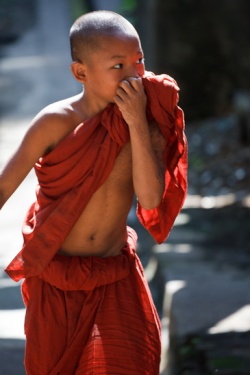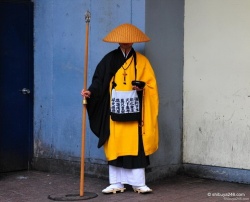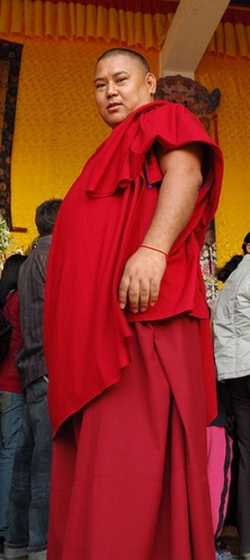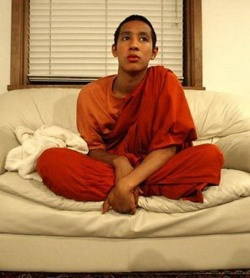Kasaya
Kāṣāya (Sanskrit: काषाय kāṣāya; Pali: kasāva; Chinese: 袈裟; pinyin: jiāshā; Cantonese Jyutping: gaa1saa1 ; Japanese: 袈裟 kesa; Korean: 袈裟 가사 gasa; Vietnamese: cà-sa), "chougu" (Tibetan) are the robes of Buddhist monks and nuns, named after a brown or saffron dye. In Sanskrit and Pali, these robes are also given the more general term cīvara, which references the robes without regard to color. The monk's robe, or cassock.
Origin and construction
Buddhist kāṣāya are said to have originated in India as set of robes for the devotees of Gautama Buddha. A notable variant has a pattern reminiscent of an Asian rice field. Original kāṣāya were constructed of discarded fabric. These were stitched together to form three rectangular pieces of cloth, which were then fit over the body in a specific manner. The three main pieces of cloth are the antarvāsa, the uttarāsaṅga, and the saṃghāti. Together they form the "triple robe," or tricīvara. The tricīvara is described more fully in the Theravāda Vinaya (Vin 1:94 289).
Antarvāsa
The antarvāsa is the inner robe covering the lower body. It is the undergarment that flows underneath the other layers of clothing. It has a large neck, and almost entirely covers the torso. In representations of the Buddha, the bottom of the antarvāsa usually protrudes, and appears in the rough shape of a triangle.
Uttarāsaṅga
A robe covering the upper body. It comes over the undergarment, or antarvāsa. In representations of the Buddha, the uttarāsaṅga rarely appears as the uppermost garment, since it is often covered by the outer robe, or saṃghāti.
Saṃghāti
The saṃghāti is an outer robe used for various occasions. It comes over the upper robe (uttarāsaṅga), and the undergarment (antarvāsa). In representations of the Buddha, the saṃghāti is usually the most visible garment, with the undergarment or uttarāsaṅga protruding at the bottom. It is quite similar in shape to the Greek himation, and its shape and folds have been treated in Greek style in the Greco-Buddhist art of Gandhāra.
Additions
Other items that may have been worn with the triple robe were:
a waist cloth, the kushalaka
a buckled belt, the samakaksika
Kāṣāya in Indian Buddhism
In India, variations of the kāṣāya robe distinguished different types of monastics. These represented the different schools that they belonged to, and their robes ranged widely from red and ochre, to blue and black.
Between 148 and 170 CE, the Parthian monk An Shigao came to China and translated a work which describes the color of monastic robes utitized in five major Indian Buddhist sects, called Da Biqiu Sanqian Weiyi (Ch. 大比丘三千威儀). Another text translated at a later date, the Śāriputraparipṛcchā, contains a very similar passage corroborating this information, but the colors for the Sarvāstivāda and Dharmaguptaka sects are reversed.
In traditions of Tibetan Buddhism, which follow the Mūlasarvāstivāda Vinaya, red robes are regarded as characteristic of the Mūlasarvāstivādins.
According to Dudjom Rinpoche from the tradition of Tibetan Buddhism, the robes of fully ordained Mahāsāṃghika monastics were to be sewn out of more than seven sections, but no more than twenty-three sections. The symbols sewn on the robes were the endless knot (Skt. śrīvatsa) and the conch shell (Skt. śaṅkha), two of the Eight Auspicious Signs in Buddhism.
Jiāshā inChinese Buddhism
InChinese Buddhism, the kāṣāya is called jiāshā (Ch. 袈裟). During the early period of Chinese Buddhism, the most common color was red. Later, the color of the robes came to serve as a way to distinguish monastics, just as they did in India. However, the colors of a Chinese Buddhist monastic's robes often corresponded to their geographical region rather than to any specific schools. By the maturation of Chinese Buddhism, only the Dharmaguptaka ordination lineage was still in use, and therefore the color of robes served no useful purpose as a designation for sects, the way that it had in India.
Kesa in Japanese Buddhism
Japanese Buddhist Priest’s Mantle (Kesa), 1775-1825. LACMA textile collections.
In Japanese Buddhism, the kāṣāya is called kesa (Jp. 袈裟). In Japan, during the Edo and Meiji periods, kesa were even sometimes pieced together from robes used in {{Wiki|Noh theatre]].



